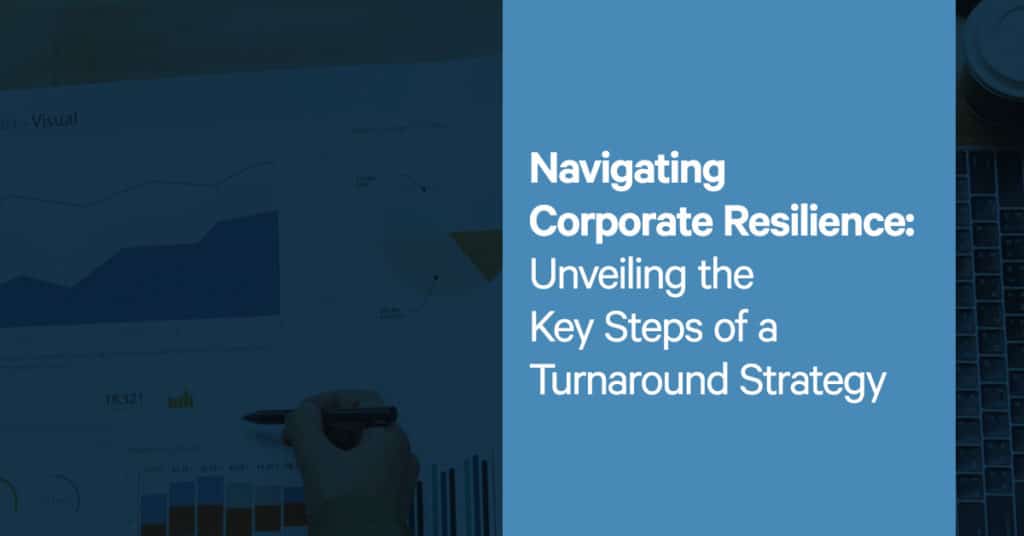For companies grappling with financial distress, navigating from crisis to stability needs more than just a casual approach. It demands a diligent roadmap and unwavering determination. For companies facing financial difficulties, a well-crafted turnaround strategy can be a guiding light, leading struggling businesses through turbulent waters towards a brighter horizon. This strategy isn’t merely a set of guidelines; it’s a lifeline, offering clarity amidst uncertainty and providing a framework for decisive action.
Step 1: Assessment and Diagnosis
The first important phase in any turnaround strategy is a comprehensive assessment of the company’s current state. This involves a thorough analysis of financial statements, operational performance, market positioning, and internal processes. By conducting an in-depth diagnosis, stakeholders gain valuable insights into the root causes of the company’s distress. Whether it’s declining revenues, excessive debt burden, operational inefficiencies, or external market pressures, understanding the underlying issues is important for crafting effective solutions. This initial step sets the foundation for the subsequent actions and interventions needed to initiate a turnaround. This phase isn’t just about identifying symptoms but understanding the fundamental issues plaguing the organisation.
Step 2: Strategic Repositioning
Armed with insights from the assessment phase, the next step in the turnaround journey is strategic repositioning. This pivotal stage involves not just recognising the need for change but fully embracing it. It requires redefining the company’s vision, mission, and strategic objectives to align with emerging market realities. This might include bold decisions such as diversifying product offerings, entering new markets, streamlining operations, or restructuring debt obligations. Strategic repositioning demands foresight, agility, and a willingness to adapt to changing circumstances. By realigning the company’s strategy with market dynamics, stakeholders can seize upon emerging opportunities and preemptively address potential threats. This phase lays the groundwork for sustainable growth by making sure that the organisation’s trajectory aligns with the evolving industry.
Step 3: Operational Optimisation
Operational inefficiencies often lie at the heart of a company’s financial woes. Addressing these inefficiencies is key to restoring profitability and competitiveness. The third step of a turnaround strategy focuses on operational optimisation, which involves identifying bottlenecks, streamlining processes, and enhancing productivity across all functional areas. This may include implementing lean management principles, investing in technology upgrades, or renegotiating supplier contracts to reduce costs. By optimising operations, companies can improve resource allocation, improve customer satisfaction, and drive bottom-line performance. Ultimately, operational optimisation isn’t just about enhancing efficiency; it’s about driving sustainable growth and profitability. By addressing operational inefficiencies, companies can position themselves for long-term success in today’s fiercely competitive marketplace. It’s a strategic investment in the company’s future, paving the way for boosted resilience, agility, and profitability in the face of evolving market dynamics.
Step 4: Financial Restructuring
Excessive debt burdens and liquidity constraints can cripple even the most promising businesses. To achieve long-term sustainability, companies must undertake a thorough review of their financial structure and explore restructuring options. This may involve renegotiating debt terms, raising fresh capital, or divesting non-core assets to improve liquidity. Financial restructuring requires careful negotiation with creditors, investors, and other stakeholders to secure favourable terms that support the company’s turnaround efforts. By addressing financial vulnerabilities head-on, companies can strengthen their balance sheets and regain the confidence of capital markets, ultimately positioning themselves for sustainable growth and success. Financial restructuring serves as a pivotal point for companies, offering the opportunity to revise their financial footing and chart a course towards prosperity. Through careful management of debt and liquidity challenges, companies can emerge from the shadows of financial distress, revitalised and ready for sustainable growth in competitive markets.
Step 5: Cultural Transformation
Corporate culture plays a key role in driving organisational performance and resilience. The final step of a turnaround strategy focuses on encouraging a culture of accountability, innovation, and continuous improvement. This requires leadership commitment, employee engagement, and effective communication to instil a shared sense of purpose and direction. Cultural transformation goes beyond structural changes; it involves nurturing a mindset of adaptability and resilience in the face of adversity. By creating a positive work environment where creativity thrives and employees are empowered to take ownership of their roles, companies can unleash their full potential and sustain long-term success.
Nurturing Resilience: A Roadmap to Recovery
Navigating corporate resilience demands a comprehensive approach that goes beyond mere survival, it’s about thriving in the face of adversity. It requires a holistic perspective, addressing not only financial and operational challenges but also cultural shifts necessary for sustainable growth. The strategic steps outlined above serve as a blueprint, guiding companies through challenging times towards stability and success. By embracing change with resilience, leveraging strengths, and learning valuable lessons from setbacks, businesses can emerge from crises transformed and renewed.
Navigating corporate resilience demands a comprehensive approach that extends beyond mere survival instincts, it’s about thriving in the face of adversity and emerging stronger and more resilient than before. It needs a holistic perspective, addressing not only immediate financial and operational challenges but also encouraging cultural shifts essential for long-term sustainability and prosperity. The strategic steps outlined above serve as a comprehensive blueprint, providing guidance and direction through the complex world of uncertainty towards stability and success. By embracing change with unwavering resilience, leveraging strengths, and learning valuable lessons from setbacks, businesses can not only weather the storm but also emerge transformed and rejuvenated. This journey is a testament to the resilience and adaptability deep-rooted in human endeavour, showing the remarkable capacity for growth and renewal even in the most challenging of circumstances.
Get Expert Help Today
If you want tailored insolvency solutions then our team of qualified Insolvency Practitioners, authorised by the Institute of Chartered Accountants in England and Wales, offers free, impartial guidance to efficiently liquidate your business. Contact us via form, live chat, email at mail@Simpleliquidation.co.uk, or call 020 3805 8311. Let us guide you through insolvency for a smooth process and empower your company to navigate corporate restructuring confidently. Reach out today to embark on your journey of resilience and transformation towards sustained success.




